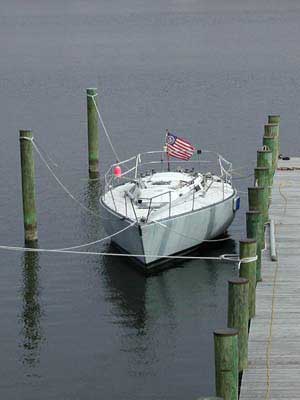Boatyard | Greyhawk | latest | next | 2005-12 | previous | oldest
GREYHAWK Progress Report
January 6, 2006
I went down to Annapolis on Monday December 26, 2005, worked on the boat on Tuesday 12/27, drove on to Savannah, Georgia, on Wednesday 12/28, returned to Annapolis Thursday 12/29, worked on the boat Friday 12/30, and returned to Keene Saturday 12/31.
The reason for the trip to Savannah was to pick up the rebuilt Yanmar
2QM15G marine diesel engine that I bought on eBay as a spare to
Greyhawk's existing 2QM15G. My father-in-law Rick went along to help
with the driving. In turns out that the seller of the engine happens to
be a retired geologist! After we got the engine loaded into my van, he
gave us a nice tour of the town, and we slept overnight aboard his
restored Grampian 31 Classic, YELLOW ROSE. All-in-all it was a great
experience.
Back at the Annapolis Boat Show in October, I had talked with one of
the guys (Collin Linehan) at the Chesapeake Rigging booth about the lens on the pressure
gauge for the Boom Vang and Backstay hydraulic system. He said take a
picture of the gauge with a ruler, and e-mail it to him. So on my trip
in November I took that picture and also some pics of the above-decks
hydraulic hoses which looked like they might benefit from replacement,
and e-mailed them to him. He said he wanted to see the boat in order to
measure for new hoses, so we made an appointment for the morning of
Tuesday 12/27. Upon Collin's arrival at the boat, he immediately started
noticing a number of other issues with the mast and rigging that
concerned him, and he suggested that we pull the rig for a thorough
survey. After some further discussion, we concurred, and scheduled to
have the mast pulled at Bert Jabin's Yacht Yard (where Chesapeake
Rigging is located) first thing on Friday 12/30.
The rest of the day Tuesday I installed a vent for the CNG tank regulator, secured the CNG fuel hose in place, secured the CNG tank in place, and tested the stove. I also replaced the section of exhaust hose on the engine between the injection elbow and the waterlift muffler, as it had a restrictive kink. There were a number of other small tasks accomplished, too.
To get over the Bert Jabin's by 8:30 Friday morning, we had to leave Mill Creek around 7:00 or so. The forecast low temperature for Thursday night was 36 degrees, so to make sure we could get Greyhawk's old engine started, we fired it up Thursday evening when we got back from Savannah, and then set up a heater on the boat to keep it warm overnight. It started without much incident and we cast off the dock just as the sun was coming up, and motored out of Mill Creek, across Whitehall Bay, and up Back Creek to Jabin's. On the way, I pulled all the halyards and other control lines off the deck and coiled them up at the base of the mast or the end of the boom. We arrived in good time, and got the boat secured. The riggers showed up on schedule at 8:30 and the crane at 9:00. The mast came out without a hitch, and the crane carried it up to and dropped it off at the Chesapeake Rigging shop shortly after 9:30. (Unfortunately the counterweight on the back of the crane clipped the bow of a boat on stands as it was making a corner, and caused a little damage, but that's not my problem...)
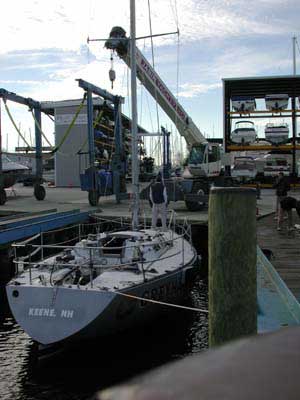
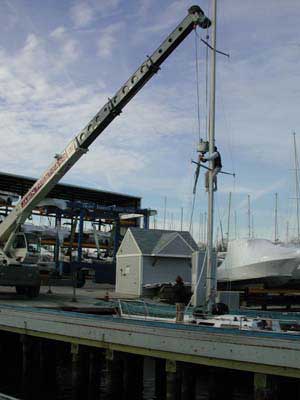
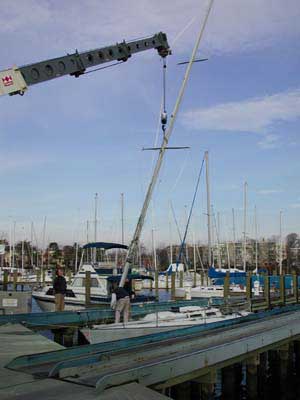
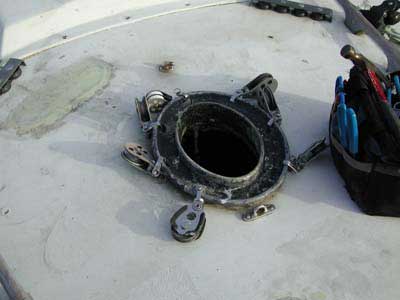
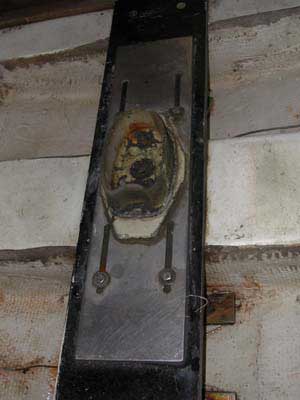
We motored Greyhawk, now naked of her mast and rigging, into the cold wind back to her dock on Mill Creek in time for lunch. We were cruising along making nearly 7 knots leaving hardly any wake. Rick was rather impressed.
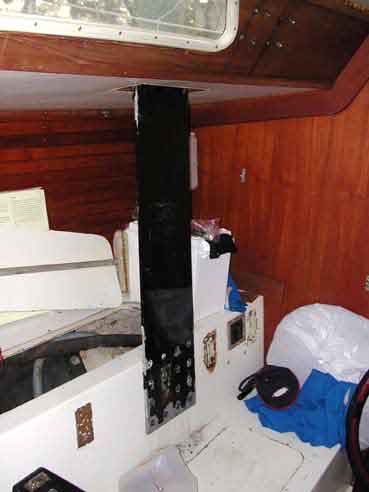
Chainplate from interior, secured to longitudinal bulkhead (setee back, a cored-fiberglass structure strongly tabbed to the hull) by sixteen 3/8" stainless steel machine screws through cored-fiberglass bulkhead and aluminum backing plate.
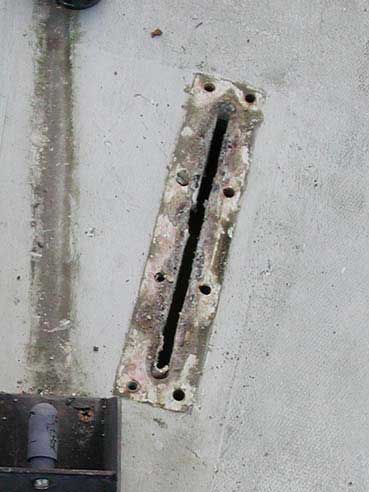
Opening in the deck where chainplate passes through.
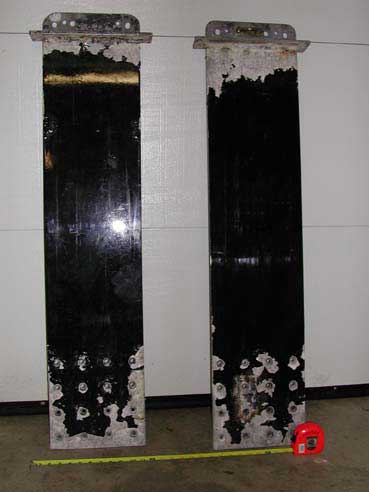
Chainplates, Aluminum 45.5" x 10" x 3/8"
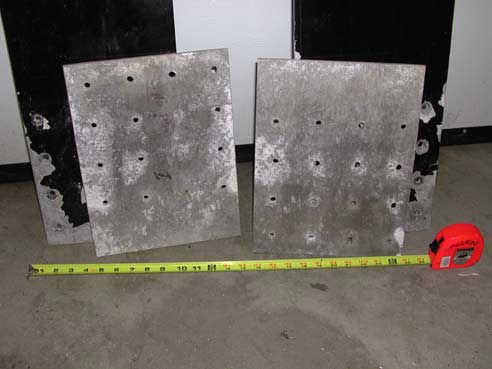
Backing plates
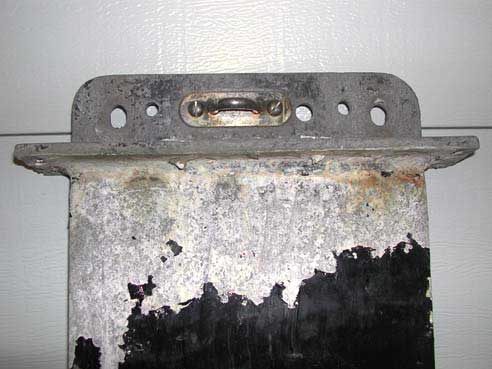
Elongated pin holes, port chainplate
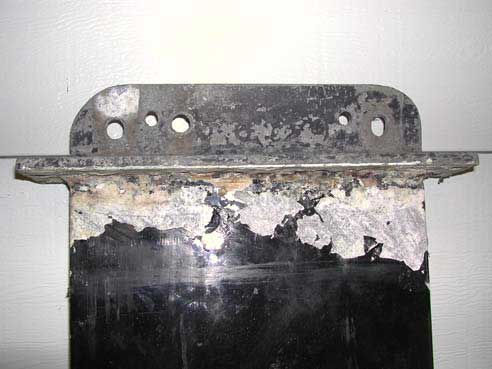
Elongated pin holes, starboard chainplate
I am now waiting for Chesapeake Rigging's survey report and list of recommendations. And I have my own list of things I would like to do with the mast and rig now that it is on the ground. I just hope we can get it put back in the boat for less than what I paid for the boat in the first place! The current plan is to try to put the mast back in the boat in mid-March. One thing I think we will go ahead with is to put a roller reefer on the forestay. This decision helps decide which of the many sails to keep and which to sell, so hopefully we can finance some of the expense through the sale of sails.
Asking around about the elongated holes in the chainplates, suggestions have ranged from replacing the whole chainplate, to drilling out the holes oversized and using a bushing to help distribute the load and reduce abrasion from the clevis pins.
Here are some "back of the envelope" engineering calculations:
The boat has -10 rod rigging, with an ultimate tensile strength of 10300 lbs. If loaded to 50% (e.g. racing margins) that's about 5000 lbs of force being exerted on the clevis pins. A 1/2" diameter pin in a 3/8" thick chainplate presents an effective cross sectional area at the hole of about 0.1875 square inches. That works out to an elongating pressure on the pin hole of about 26,667 pounds per square inch!
With the mushrooming, the width of the chainplates in the area of the hole has increased, let's say to 1/2", so the effective cross sectional area is maybe .25 square inches, and the elongating pressure has dropped to 20,000 psi.
If I drill the pin holes out to 3/4" (and thus bring the chainplates back to 3/8" thick), and put an 1/8" thick bushing around my 1/2" clevis pins, then the effective cross-sectional area at the hole in the aluminum goes to about 0.28 square inches, and the elongating pressure on the pin hole decreases to about 17,778 psi (assuming 5000 lbs tension in the rigging).
Ted Brewer wrote an article in Good Old Boat about metal boats that had some data on the ultimate tensile strength and yield strengths of several metals, including the Aluminum alloys 5086 (hull plating) and 6061 (mast extrusion). The yield strength of 6061 alloy was given as 35,000 psi, but that reduces to only 19,000 psi if welded. (Ultimate tensile strengths were 42,000 psi or 30,000 psi if welded.) The 5086 alloy does a bit better.
Progress Report, February 3, 2006
Greyhawk Crew,
After a week of back-and-forth with my rigging consultant (Collin Linehan at Chesapeake Rigging), and seeking advice from many others, I've decided that in the end, the rig is just not a place to mess around. (See December Progress Report for discussion of unstepping the mast for a rig survey)
So I'm going to go with the "complete package" in the Rigger's proposal. This will include new chainplates, as well as repairing the crack in the mast, replacing all of the rod-rigging (including turnbuckles), servicing the hydraulic cylinders for both backstay and vang, replacing the hydraulic system pressure gauge, adding a shiv-box to the front of the boom for single-line reefing, adding tangs and halyard blocks for a removable inner fore-stay and running back stays, fixing the check stays, installing a Shaefer System 2100 roller furler, replacing two halyards, installing lazy jacks, replacing all of the electrical wiring and installing a new masthead tricolor/anchor light, and prep and painting (Awlgrip) of both spars. Oh, and they're going to put the mast back into the boat and set it all up, too.
(In case you're wondering, although wire is less expensive than rod, and making up wire stays and shrouds is a DIY proposition, switching my rig from rod to wire would have required re-doing all the spreader bases, among other things, which meant that wire rigging would have cost more than new rods. Rod rigging does have the advantages of less weight and windage aloft, less stretch, and the potential for longer life than wire.)
All of this adds up to quite a few pretty pennies (several more than I paid for the boat itself, in fact) -- I'm really going to be scraping the bottom of the barrel to pay for this now (I do have some help from my "sponsor" -- Thanks!). But it is all work that I anticipated would need to be done sooner or later -- I just didn't anticipate doing it all at once! Much of it is work that I could not (and/or would not want to) do myself: welding aluminum, cold-heading the rod rigging, rebuilding hydraulic cylinders... Certainly some of the work I could do myself, including the painting and prep, electrical wiring, etc..., but I don't have the mast sitting at home -- it's 450 miles away! Plus, I do have a full-time job, and as my wife points out, she's the one who does all the painting around our house. That, and I really do want to go sailing this summer !-)
We're aiming to re-step the mast sometime during the week of March 13.
I'm really starting to look forward to our delivery voyage planned for the last week in June.
March 2006 Report on Rigging Upgrades and Repairs
Boatyard | Greyhawk | latest | next | 2005-12 | previous | oldest
website by thorpeallen.net
January 2010
